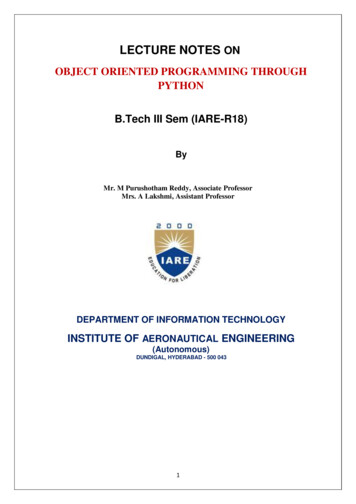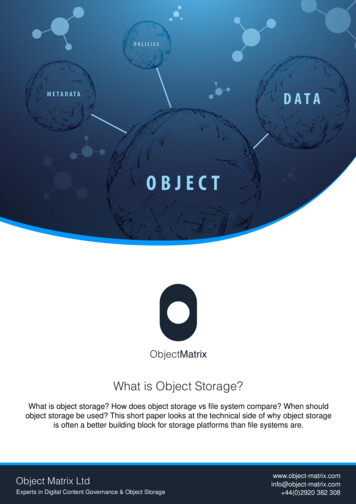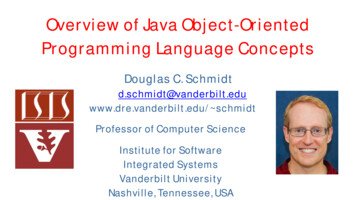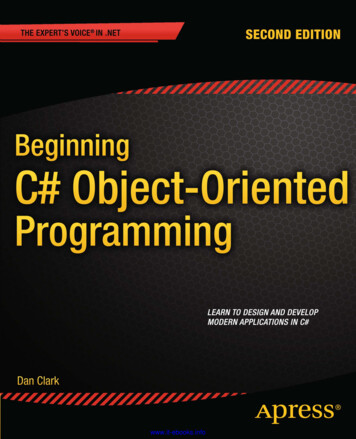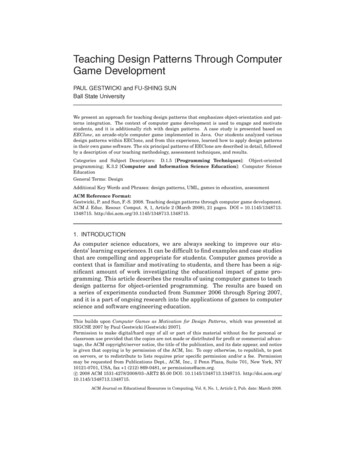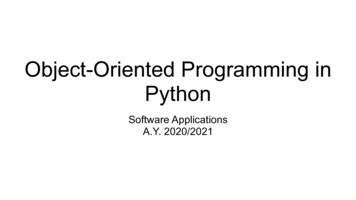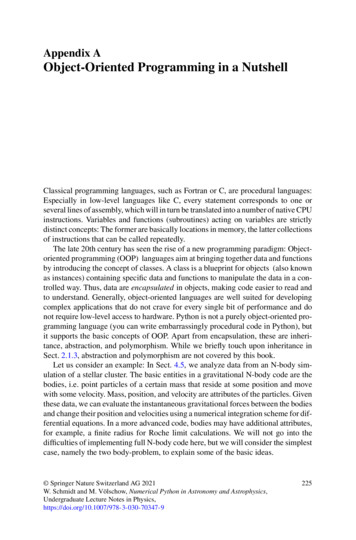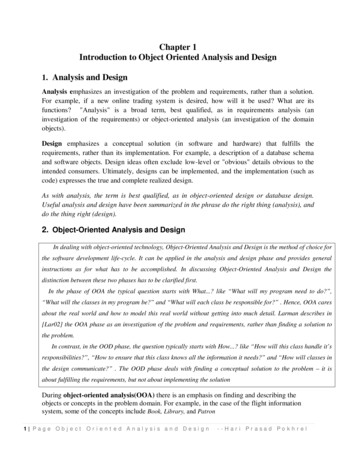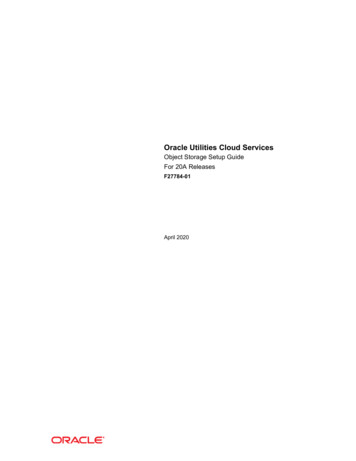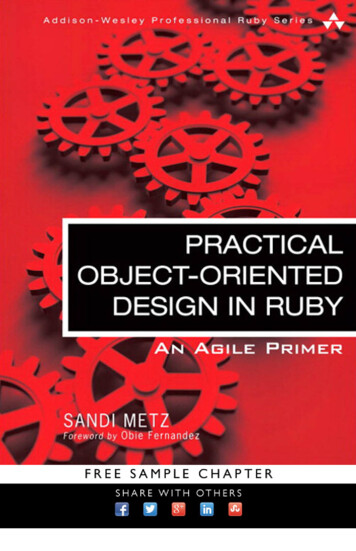
Transcription
Praise for Practical Object-Oriented Design in Ruby“This is great stuff! Your descriptions are so vibrant and vivid that I'm rediscovering the truthburied in OO principles that are otherwise so internalized that I forget to explore them. Yourthoughts on design and knowing the future are especially eloquent.”—Ian McFarland, President, New Context, Inc.“As a self-taught programmer, this was an extremely helpful dive into some OOP concepts that Icould definitely stand to become better acquainted with! And, I’m not alone: there’s a sign postedat work that reads, “WWSMD?—What Would Sandi Metz Do”?—Jonathan Mukai, Pivotal in NYC“Meticulously pragmatic and exquisitely articulate, Practical Object Oriented Design in Rubymakes otherwise elusive knowledge available to an audience which desperately needs it. The prescriptions are appropriate both as rules for novices and as guidelines for experienced professionals.”—Katrina Owen, developer, Bengler“I do believe this will be the most important Ruby book of 2012. Not only is the book 100%on-point, Sandi has an easy writing style with lots of great analogies that drive every point home.”—Avdi Grimm, Author of Exceptional Ruby and Objects on Rails“While Ruby is an object-oriented language, little time is spent in the documentation on whatOO truly means or how it should direct the way we build programs. Here Metz brings it to thefore, covering most of the key principles of OO development and design in an engaging, easy-tounderstand manner. This is a must for any respectable Ruby bookshelf.”—Peter Cooper, editor, Ruby Weekly“So good, I couldn’t put it down! This is a must-read for anyone wanting to do object-oriented programming in any language, not to mention it has completely changed the way I approach testing.”—Charles Max Wood, video and audio show host, TeachMeToCode.com“Distilling scary OO design practices with clear-cut examples and explanations makes this a bookfor novices and experts alike. It is well worth the study by anyone interested in OO design beingdone right and ‘light.’ I thoroughly enjoyed this book.”—Manuel Pais, editor, InfoQ.com“If you call yourself a Ruby programmer, you should read this book. It’s jam-packed with great nuggetsof practical advice and coding techniques that you can start applying immediately in your projects.”—Ylan Segal, San Diego Ruby User Group“This is the best OO book I’ve ever read. It’s short, sweet, but potent. It slowly moves from simpletechniques to more advanced, each example improving on the last. The ideas it presents are usefulnot just in Ruby but in static languages like C# too. Highly recommended!”—Kevin Berridge, software engineering manager, Pointe BlankSolutions, and organizer, Burning River Developers Meetup
“The book is just perfect! The elegance of Ruby shines but it also works as an A to Z of objectoriented programming in general.”—Emil Rondahl, C# & .NET consultant“This is an exceptional Ruby book, in which Metz offers a practical look at writing maintainable,clean, idiomatic code in Ruby. Absolutely fantastic, recommended for my Ruby hacker friends.”—Zachary “Zee” Spencer, freelancer & coach“This is the best programming book I’ve read in ages. Sandi talks about basic principles, but theseare things we’re probably still doing wrong and she shows us why and how. The book has the perfect mix of code, diagrams, and words. I can’t recommend it enough and if you’re serious aboutbeing a better programmer, you’ll read it and agree.—Derick Hitchcock, senior developer, SciMed Solutions“I predict this will become a classic. I have an uncomfortable familiarity with programming literature, and this book is on a completely different level. I am astonished when I find a book thatoffers new insights and ideas, and even more surprised when it can do so, not just once, butthroughout the pages. This book is excellently written, well-organized, with lucid explanations oftechnical programming concepts.”—Han S. Kang, software engineer and member of the LA Rubyists“You should read this book if you write software for a living. The future developers who inherityour code will thank you.”—Jose Fernandez, senior software engineer at New Relic“Metz’s take on the subject is rooted strongly in theory, but the explanation always stays groundedin real world concerns, which helped me to internalize it. The book is clear and concise, yetachieves a tone that is more friendly than terse.”—Alex Strasheim, network administrator, Ensemble Travel Group“This is an amazing book about just how to do object-oriented thinking when you’re programming in Ruby. Although there are some chapters that are more Ruby-specific, this book could be agreat resource for developers in any language. All in all, I can’t recommend this book enough.”—James Hwang, thriceprime.com“Whether you’re just getting started in your software development career, or you’ve been coding foryears (like I have), it’s likely that you’ll learn a lot from Ms. Metz’s book. She does a fantastic jobof explaining the whys of well-designed software along with the hows.”—Gabe Hollombe, software craftsman, avantbard.com“In short, this is in my top five programming books I’ve ever read. I believe that in twenty years thiswill be considered one of the definitive works on object-oriented programming. I plan to re-read it atleast once a year to keep my skills from falling into atrophy. If you’re a relatively new, intermediate,or even somewhat advanced OO developer in any language, purchasing this book is the best wayI know to level up your OO design skills.”—Brandon Hays, freelance software developer
PRACTICAL OBJECT-ORIENTEDDESIGN IN RUBY
Addison-WesleyProfessional Ruby SeriesObie Fernandez, Series EditorVisit informit.com /ruby for a complete list of available products.The Addison-Wesley Professional Ruby Series provides readerswith practical, people-oriented, and in-depth information aboutapplying the Ruby platform to create dynamic technology solutions.The series is based on the premise that the need for expert referencebooks, written by experienced practitioners, will never be satisfied solelyby blogs and the Internet.
PRACTICAL OBJECT-ORIENTEDDESIGN IN RUBYAn Agile PrimerSandi MetzUpper Saddle River, NJ Boston Indianapolis San FranciscoNew York Toronto Montreal London Munich Paris MadridCapetown Sydney Tokyo Singapore Mexico City
Many of the designations used by manufacturers and sellers to distinguish theirproducts are claimed as trademarks. Where those designations appear in thisbook, and the publisher was aware of a trademark claim, the designations havebeen printed with initial capital letters or in all capitals.Editor-in-ChiefMark TaubThe author and publisher have taken care in the preparation of this book, butmake no expressed or implied warranty of any kind and assume no responsibility for errors or omissions. No liability is assumed for incidental or consequential damages in connection with or arising out of the use of the information orprograms contained herein.Development EditorMichael ThurstonThe publisher offers excellent discounts on this book when ordered in quantityfor bulk purchases or special sales, which may include electronic versions and/orcustom covers and content particular to your business, training goals, marketingfocus, and branding interests. For more information, please contact:U.S. Corporate and Government Sales(800) 382-3419corpsales@pearsontechgroup.comFor sales outside the United States, please contact:International Salesinternational@pearson.comVisit us on the Web: informit.com/awLibrary of Congress Cataloging-in-Publication DataMetz, Sandi.Practical object-oriented design in Ruby : an agile primer / Sandi Metz.p. cm.Includes bibliographical references and index.ISBN 0-321-72133-0 (alk. paper)1. Object-oriented programming (Computer science) 2. Ruby (Computerprogram language) I. Title.QA76.64.M485 2013005.1'17—dc232012026008Copyright 2013 Pearson Education, Inc.All rights reserved. Printed in the United States of America. This publicationis protected by copyright, and permission must be obtained from the publisherprior to any prohibited reproduction, storage in a retrieval system, or transmissionin any form or by any means, electronic, mechanical, photocopying, recording,or likewise. To obtain permission to use material from this work, please submit awritten request to Pearson Education, Inc., Permissions Department, One LakeStreet, Upper Saddle River, New Jersey 07458, or you may fax your request to(201) 236-3290.ISBN-13: 978-0-321-72133-4ISBN-10:0-321-72133-0Text printed in the United States at RR Donnelley in Crawfordsville, Indiana.Second printing, April 2013Acquisitions EditorDebra Williams CauleyManaging EditorJohn FullerProject EditorElizabeth RyanPackagerLaserwordsCopy EditorPhyllis CrittendenIndexerConstance A. AngeloProofreaderGina DelaneyPublishing CoordinatorKim BoedigheimerCover DesignerChuti PrasertsithCompositorLaserwords
For Amy, who read everything first
This page intentionally left blank
xxiAbout the AuthorxxiiiObject-Oriented Design1In Praise of Design 2The Problem Design Solves 2Why Change Is Hard 3A Practical Definition of Design 4The Tools of Design 4Design Principles 5Design Patterns 6The Act of Design 7How Design Fails 7When to Design 8Judging Design 10A Brief Introduction to Object-Oriented ProgrammingProcedural Languages 12Object-Oriented Languages 12Summary 14211Designing Classes with a Single Responsibility 15Deciding What Belongs in a Class 16Grouping Methods into Classes 16Organizing Code to Allow for Easy Changes16ix
xContentsCreating Classes That Have a Single Responsibility 17An Example Application: Bicycles and Gears 17Why Single Responsibility Matters 21Determining If a Class Has a Single Responsibility 22Determining When to Make Design Decisions 22Writing Code That Embraces Change 24Depend on Behavior, Not Data 24Enforce Single Responsibility Everywhere 29Finally, the Real Wheel 33Summary 343Managing Dependencies 35Understanding Dependencies 36Recognizing Dependencies 37Coupling Between Objects (CBO) 37Other Dependencies 38Writing Loosely Coupled Code 39Inject Dependencies 39Isolate Dependencies 42Remove Argument-Order DependenciesManaging Dependency Direction 51Reversing Dependencies 51Choosing Dependency Direction 53Summary 57446Creating Flexible Interfaces 59Understanding Interfaces 59Defining Interfaces 61Public Interfaces 62Private Interfaces 62Responsibilities, Dependencies, and Interfaces 62Finding the Public Interface 63An Example Application: Bicycle Touring CompanyConstructing an Intention 64Using Sequence Diagrams 6563
ContentsxiAsking for “What” Instead of Telling “How” 69Seeking Context Independence 71Trusting Other Objects 73Using Messages to Discover Objects 74Creating a Message-Based Application 76Writing Code That Puts Its Best (Inter)Face Forward 76Create Explicit Interfaces 76Honor the Public Interfaces of Others 78Exercise Caution When Depending on Private InterfacesMinimize Context 79The Law of Demeter 80Defining Demeter 80Consequences of Violations 80Avoiding Violations 82Listening to Demeter 82Summary 835Reducing Costs with Duck Typing 85Understanding Duck Typing 85Overlooking the Duck 87Compounding the Problem 87Finding the Duck 90Consequences of Duck Typing 94Writing Code That Relies on Ducks 95Recognizing Hidden Ducks 96Placing Trust in Your Ducks 98Documenting Duck Types 98Sharing Code Between Ducks 99Choosing Your Ducks Wisely 99Conquering a Fear of Duck Typing 100Subverting Duck Types with Static TypingStatic versus Dynamic Typing 101Embracing Dynamic Typing 102Summary 10410079
xii6ContentsAcquiring Behavior Through Inheritance 105Understanding Classical Inheritance 105Recognizing Where to Use Inheritance 106Starting with a Concrete Class 106Embedding Multiple Types 109Finding the Embedded Types 111Choosing Inheritance 112Drawing Inheritance Relationships 114Misapplying Inheritance 114Finding the Abstraction 116Creating an Abstract Superclass 117Promoting Abstract Behavior 120Separating Abstract from Concrete 123Using the Template Method Pattern 125Implementing Every Template Method 127Managing Coupling Between Superclasses and Subclasses 129Understanding Coupling 129Decoupling Subclasses Using Hook Messages 134Summary 1397Sharing Role Behavior with Modules 141Understanding Roles 142Finding Roles 142Organizing Responsibilities 143Removing Unnecessary DependenciesWriting the Concrete Code 147Extracting the Abstraction 150Looking Up Methods 154Inheriting Role Behavior 158Writing Inheritable Code 158Recognize the Antipatterns 158Insist on the Abstraction 159Honor the Contract 159145
ContentsUse the Template Method Pattern 160Preemptively Decouple Classes 161Create Shallow Hierarchies 161Summary 1628Combining Objects with Composition 163Composing a Bicycle of Parts 164Updating the Bicycle Class 164Creating a Parts Hierarchy 165Composing the Parts Object 168Creating a Part 169Making the Parts Object More Like an Array 172Manufacturing Parts 176Creating the PartsFactory 177Leveraging the PartsFactory 178The Composed Bicycle 180Deciding Between Inheritance and Composition 184Accepting the Consequences of Inheritance 184Accepting the Consequences of Composition 187Choosing Relationships 188Summary 1909Designing Cost-Effective Tests 191Intentional Testing 192Knowing Your Intentions 193Knowing What to Test 194Knowing When to Test 197Knowing How to Test 198Testing Incoming Messages 200Deleting Unused Interfaces 202Proving the Public Interface 203Isolating the Object Under Test 205Injecting Dependencies Using Classes 207Injecting Dependencies as Roles 208xiii
xivContentsTesting Private Methods 213Ignoring Private Methods During Tests 213Removing Private Methods from the Class Under TestChoosing to Test a Private Method 214Testing Outgoing Messages 215Ignoring Query Messages 215Proving Command Messages 216Testing Duck Types 219Testing Roles 219Using Role Tests to Validate Doubles 224Testing Inherited Code 229Specifying the Inherited Interface 229Specifying Subclass Responsibilities 233Testing Unique Behavior 236Summary 240Afterword 241Index 243214
ForewordOne of the core truisms of software development is that as your code grows andrequirements for the system that you are building change, additional logic will beadded that is not yet present in the current system. In almost all cases, maintainabilityover the life of the code is more important than optimizing its present state.The promise of using object-oriented (OO) design is that your code will be easierto maintain and evolve than otherwise. If you are new to programming, how do youunlock these secrets to maintainability using OO? The fact is that many of us havenever had holistic training in writing clean object-oriented code, instead picking upour techniques through osmosis from colleagues and a myriad of older books andonline sources. Or if we were given a primer in OO during school, it was done in languages such as Java or C . (The lucky ones were taught using Smalltalk!)Sandi Metz’s Practical Object-Oriented Design in Ruby covers all of the basics ofOO using the Ruby language, meaning that it’s ready to usher countless Ruby andRails newcomers to the next steps in their professional development as mature programmers.Ruby itself, like Smalltalk, is a completely object-oriented (OO) language.Everything in it, even primitive data constructs such as strings and numbers, is represented by objects with behavior. When you write your own applications in Ruby, youdo so by coding your own objects, each encapsulating some state and defining its ownbehavior. If you don’t already have OO experience, it can feel daunting to know howto start the process. This book guides you every step of the way, from the most basicquestions of what to put in a class, through basic concepts such as the SingleResponsibility Principle, all the way through to making tradeoffs between inheritanceand composition, and figuring out how to test objects in isolation.The best part, though, is Sandi’s voice. She’s got a ton of experience and is one ofthe nicest members of the community you’ll ever meet, and I think she did a great jobxv
xviForewordgetting that feeling across in her writing. I’ve known Sandi for several years now, and Iwondered if her manuscript would live up to the pleasure of actually getting to knowSandi in real life. I’m glad to say that it does, in spades, which is why I’m glad to welcome her as our newest author to the Professional Ruby Series.—Obie Fernandez, Series EditorAddison Wesley Professional Ruby Series
IntroductionWe want to do our best work, and we want the work we do to have meaning. And, allelse being equal, we prefer to enjoy ourselves along the way.Those of us whose work is to write software are incredibly lucky. Building software is a guiltless pleasure because we get to use our creative energy to get thingsdone. We have arranged our lives to have it both ways; we can enjoy the pure act ofwriting code in sure knowledge that the code we write has use. We produce thingsthat matter. We are modern craftspeople, building structures that make up presentday reality, and no less than bricklayers or bridge builders, we take justifiable pride inour accomplishments.This all programmers share, from the most enthusiastic newbie to the apparentlyjaded elder, whether working at the lightest weight Internet startup or the most staid,long-entrenched enterprise. We want to do our best work. We want our work to havemeaning. We want to have fun along the way.And so it’s especially troubling when software goes awry. Bad software impedesour purpose and interferes with our happiness. Where once we felt productive, nowwe feel thwarted. Where once fast, now slow. Where once peaceful, now frustrated.This frustration occurs when it costs too much to get things done. Our internalcalculators are always running, comparing total amount accomplished to overall effortexpended. When the cost of doing work exceeds its value, our efforts feel wasted. Ifprogramming gives joy it is because it allows us to be useful; when it becomes painfulit is a sign that we believe we could, and should, be doing more. Our pleasure followsin the footsteps of work.This book is about designing object-oriented software. It is not an academictome, it is a programmer’s story about how to write code. It teaches how to arrangesoftware so as to be productive today and to remain so next month and next year. Itshows how to write applications that can succeed in the present and still adapt to thexvii
xviiiIntroductionfuture. It allows you to raise your productivity and reduce your costs for the entirelifetime of your applications.This book believes in your desire to do good work and gives you the tools youneed to best be of use. It is completely practical and as such is, at its core, a book abouthow to write code that brings you joy.Who Might Find This Book Useful?This book assumes that you have at least tried to write object-oriented software. It isnot necessary that you feel you succeeded, just that you made the attempt in any objectoriented (OO) language. Chapter 1 contains a brief overview of object-orientedprogramming (OOP) but its goal is to define common terms, not to teach programming.If you want to learn OO design (OOD) but have not yet done any object-orientedprogramming, at least take a tutorial before reading this book. OO design solves problems; suffering from those problems is very nearly a prerequisite for comprehendingthese solutions. Experienced programmers may be able to skip this step but most readerswill be happier if they write some OO code before starting this book.This book uses Ruby to teach OOD but you do not need to know Ruby tounderstand the concepts herein. There are many code examples but all are quitestraightforward. If you have programmed in any OO language you will find Ruby easyto understand.If you come from a statically typed OO language like Java or C you have thebackground necessary to benefit from reading this book. The fact that Ruby isdynamically typed simplifies the syntax of the examples and distills the design ideas totheir essence, but every concept in this book can be directly translated to a staticallytyped OO language.How to Read This BookChapter 1, Object-Oriented Design, contains a general overview of the whys, whensand wherefores of OO design, followed by a brief overview of object-orientedprogramming. This chapter stands alone. You can read it first, last, or, frankly, skip itentirely, although if you are currently stuck with an application that suffers from lackof design you may find it a comforting tale.If you have experience writing object-oriented applications and want to jumpright in, you can safely start with Chapter 2. If you do so and then stumble upon an
Introductionxixunfamiliar term, come back and browse the Introduction to Object-OrientedProgramming section of Chapter 1, which introduces and defines common OO termsused throughout the book.Chapters 2 through 9 progressively explain object-oriented design. Chapter 2,Designing Classes with a Single Responsibility, covers how to decide what belongs in asingle class. Chapter 3, Managing Dependencies, illustrates how objects get entangledwith one another and shows how to keep them apart. These two chapters are focusedon objects rather than messages.In Chapter 4, Creating Flexible Interfaces, the emphasis begins to shift away fromobject-centric towards message-centric design. Chapter 4 is about defining interfacesand is concerned with how objects talk to one another. Chapter 5, Reducing Costs withDuck Typing, is about duck typing and introduces the idea that objects of differentclasses may play common roles. Chapter 6, Acquiring Behavior Through Inheritance,teaches the techniques of classical inheritance, which are then used in Chapter 7,Sharing Role Behavior with Modules, to create duck typed roles. Chapter 8,Combining Objects with Composition, explains the technique of building objects viacomposition and provides guidelines for choosing among composition, inheritance,and duck-typed role sharing. Chapter 9, Designing Cost-Effective Tests, concentrateson the design of tests, which it illustrates using code from earlier chapters of the book.Each of these chapters builds on the concepts of the last. They are full of code andbest read in order.How to Use This BookThis book will mean different things to readers of different backgrounds. Thosealready familiar with OOD will find things to think about, possibly encounter somenew points of view, and probably disagree with a few of the suggestions. Because thereis no final authority on OOD, challenges to the principles (and to this author) willimprove the understanding of all. In the end you must be the arbiter of your owndesigns; it is up to you to question, to experiment, and to choose.While this book should be of interest to many levels of reader, it is written withthe particular goal of being accessible to novices. If you are one of those novices, thispart of the introduction is especially for you. Know this: object-oriented design is notblack magic. It is simply things you don’t yet know. The fact that you’ve read this farindicates you care about design; this desire to learn is the only prerequisite for benefitingfrom this book.
xxIntroductionChapters 2 through 9 explain OOD principles and provide very explicit programming rules; these rules will mean different things to novices than they mean to experts.If you are a novice, start out by following these rules in blind faith if necessary. Thisearly obedience will stave off disaster until you can gain enough experience to makeyour own decisions. By the time the rules start to chafe, you’ll have enough experienceto make up rules of your own and your career as a designer will have begun.
AcknowledgmentsIt is a wonder this book exists; the fact that it does is due to the efforts and encouragement of many people.Throughout the long process of writing, Lori Evans and TJ Stankus providedearly feedback on every chapter. They live in Durham, NC, and thus could not escapeme, but this fact does nothing to lessen my appreciation for their help.Midway through the book, after it became impossible to deny that its writingwould take approximately twice as long as originally estimated, Mike Dalessio andGregory Brown read drafts and gave invaluable feedback and support. Their encouragement and enthusiasm kept the project alive during dark days.As it neared completion, Steve Klabnik, Desi McAdam, and Seth Wax reviewedthe book and thus acted as gracious stand-ins for you, the gentle reader. Their impressions and suggestions caused changes that will benefit all who follow.Late drafts were given careful, thorough readings by Katrina Owen, Avdi Grimm,and Rebecca Wirfs-Brock, and the book is much improved by their kind and thoughtful feedback. Before they pitched in, Katrina, Avdi, and Rebecca were strangers to me;I am grateful for their involvement and humbled by their generosity. If you find thisbook useful, thank them when you next see them.I am also grateful for the Gotham Ruby Group and for everyone who expressedtheir appreciation for the design talks I gave at GoRuCo 2009 and 2011. The folks atGoRuCo took a chance on an unknown and gave me a forum in which to expressthese ideas; this book started there. Ian McFarland and Brian Ford watched those talksand their immediate and ongoing enthusiasm for this project was both infectious andconvincing.xxi
xxiiAcknowledgmentsThe process of writing was greatly aided by Michael Thurston of Pearson Education,who was like an ocean liner of calmness and organization chugging through the chaoticsea of my opposing rogue writing waves. You can, I expect, see the problem he faced. Heinsisted, with endless patience and grace, that the writing be arranged in a readablestructure. I believe his efforts have paid off and hope you will agree.My thanks also to Debra Williams Cauley, my editor at Addison-Wesley, whooverheard an ill-timed hallway rant in 2006 at the first Ruby on Rails conference inChicago and launched the campaign that eventually resulted in this book. Despitemy best efforts, she would not take no for an answer. She cleverly moved from oneargument to the next until she finally found the one that convinced; this accuratelyreflects her persistence and dedication.I owe a debt to the entire object-oriented design community. I did not make upthe ideas in this book, I am merely a translator, and I stand on the shoulders ofgiants. It goes without saying that while all credit for these ideas belongs to others—failures of translation are mine alone.And finally, this book owes its existence to my partner Amy Germuth. Beforethis project started I could not imagine writing a book; her view of the world as aplace where people did such things made doing so seem possible. The book in yourhands is a tribute to her boundless patience and endless support.Thank you, each and every one.
About the AuthorSandi Metz has 30 years of experience working on projects that survived to grow andchange. She writes code every day as a software architect at Duke University, where herteam solves real problems for customers who have large object-oriented applicationsthat have been evolving for 15 or more years. She’s committed to getting useful softwareout the door in extremely practical ways. Practical Object-Oriented Design in Ruby isthe distillation of many years of whiteboard drawings and the logical culmination of alifetime of conversations about OO design. Sandi has spoken at Ruby Nation and severaltimes at Gotham Ruby User’s Conference and lives in Durham, NC.xxiii
This page intentionally left blank
C HAPTER 3Managing DependenciesObject-oriented programming languages contend that they are efficient and effectivebecause of the way they model reality. Objects reflect qualities of a real-world problemand the interactions between those objects provide solutions. These interactions areinescapable. A single object cannot know everything, so inevitably it will have to talkto another object.If you could peer into a busy application and watch the messages as they pass, thetraffic might seem overwhelming. There’s a lot going on. However, if you stand backand take a global view, a pattern becomes obvious. Each message is initiated by anobject to invoke some bit of behavior. All of the behavior is dispersed among theobjects. Therefore, for any desired behavior, an object either knows it personally,inherits it, or knows another object who knows it.The previous chapter concerned itself with the first of these, that is, behaviorsthat a class should personally implement. The second, inheriting behavior, will becovered in Chapter 6, Acquiring Behavior Through Inheritance. This chapter isabout the third, getting access to behavior when that behavior is implemented inother objects.Because well designed objects have a single responsibility, their very nature requiresthat they collaborate to accomplish complex tasks. This collaboration is powerful andperilous. To collaborate, an object must know something know about others. Knowingcreates a dependency. If not managed carefully, these dependencies will strangle yourapplication.35
36Chapter 3. Managing DependenciesUnderstanding DependenciesAn object depends on another object if, when one object changes, the other might beforced to change in turn.Here’s a modified version of the Gear class, where Gear is initialized with four familiar arguments. The gear inches method uses two of them, rim and tire, tocreate a new instance of Wheel. Wheel has not changed since you last you saw it inChapter 2, Designing Classes with a Single 2324252627282930313233class Gearattr r
The elegance of Ruby shines but it also works as an A to Z of object-oriented programming in general." —Emil Rondahl, C# & .NET consultant "This is an exceptional Ruby book, in which Metz offers a practical look at writing maintainable, clean, idiomatic code in Ruby. Absolutely fantastic, recommended for my Ruby hacker friends."
